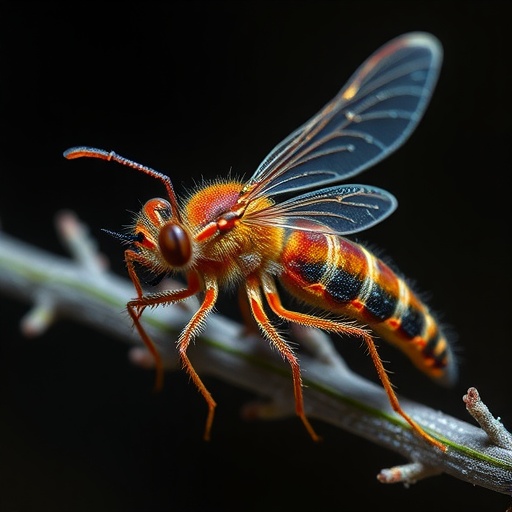
In the realm of evolutionary biology and taxonomy, the recent study authored by Bellini et al. embarks on a pioneering exploration of the mitogenomic data associated with Seirinae, a fascinating subgroup of Collembola within the family Entomobryidae. In the context of contemporary scientific inquiry, the analysis of mitochondrial genomes has become a powerful tool, providing invaluable insights into evolutionary relationships, geographical distributions, and taxonomic classifications. This innovative research stands to reshape our understanding of Seirinae by integrating cutting-edge genomic techniques with classical taxonomy.
Mitochondrial DNA (mtDNA) has long been recognized as a vital component in the study of evolutionary processes. Its relatively rapid mutation rates make it particularly suitable for establishing phylogenetic relationships among species. This study not only leverages traditional methodologies but also pioneers the use of mitogenomic data to delve deeper into the evolutionary narrative of Seirinae. By examining variations at the mitochondrial genome level, the authors illuminate the complex patterns of inheritance and divergence that characterize these minute yet ecologically significant organisms.
The Seirinae subfamily is an important group of soil-dwelling arthropods known for their incredible biodiversity and adaptability to various terrestrial environments. The need for comprehensive genomic studies in this area has never been more pressing, as many Seirinae species face the threat of extinction due to habitat loss and climate change. Understanding their evolutionary history is crucial for developing effective conservation strategies, making the findings of this research not only scientifically significant but also socially relevant.
In their study, Bellini and colleagues gathered mtDNA sequences from a broad sampling of Seirinae taxa, aiming to create a robust dataset that reflects the phylogenetic diversity within the subfamily. This comprehensive approach is critical, as it enables a more nuanced understanding of the evolutionary processes that have given rise to the current array of species. Utilizing advanced sequencing technologies and bioinformatics tools, the researchers generated high-quality genomic data that would inform their subsequent analyses.
One of the standout aspects of this research is its focus on elucidating the historical biogeography of Seirinae. By integrating mitogenomic data with environmental and geographical information, the authors trace the dispersal patterns of these organisms across different ecosystems. Such analyses reveal how historical climate fluctuations and geological events have shaped the distribution of Seirinae species over millions of years. This level of detail allows researchers to construct a comprehensive picture of how these organisms have adapted to their surroundings.
Taxonomic classification within the Seirinae subfamily has traditionally relied on morphological traits, which can be subjective and sometimes misleading. The introduction of genomic data shifts the paradigm, providing a more objective and precise means of defining taxonomic boundaries. For instance, the study demonstrates that some species previously considered distinct may actually share a closer genetic relationship than previously understood. This revelation could lead to a reevaluation of the current classification schemes, fostering a more accurate reflection of evolutionary relationships among Seirinae.
Furthermore, the implications of this research extend beyond taxonomy and biogeography. By providing insights into the genetic diversity of Seirinae, the study opens avenues for understanding the ecological roles these organisms play within their habitats. Soil health, ecosystem stability, and nutrient cycling are just a few of the critical functions that Seirinae contribute to. Recognizing these roles reinforces the urgency of conserving not only individual species but also the ecosystems they inhabit.
The methodology employed in this study is noteworthy for its interdisciplinary nature. It brings together genetics, ecology, and evolutionary biology to form a cohesive understanding of Seirinae evolution. The authors utilized phylogenomic analyses to construct evolutionary trees that depict relationships among various taxa, demonstrating the utility of mitogenomics in resolving complex evolutionary questions. This holistic approach serves as a model for future studies aimed at elucidating the evolutionary histories of other lesser-known taxa.
Of particular interest in the study is the discussion surrounding the ongoing challenges and future directions in Collembola research. While significant advancements have been made, the authors emphasize the need for continued investment in both genomic technologies and biodiversity assessments. As ecosystems continue to face unprecedented changes, understanding cryptic lineages and assessing genetic diversity becomes crucial for predicting responses to environmental stressors. By advocating for a genomic approach to conservation, this study encourages a proactive stance in safeguarding biodiversity.
This research also presents an opportunity for increased public awareness regarding the importance of microscopic fauna like Seirinae. Often overlooked, these small organisms play crucial roles in maintaining ecosystem health. The authors highlight the need for outreach and education efforts to emphasize the significance of soil-dwelling arthropods in broader ecological contexts. As stewards of biodiversity, scientists and conservationists alike must work together to communicate the findings of such research to a wider audience.
In summary, the exploration conducted by Bellini et al. unveils a treasure trove of information about Seirinae that significantly enhances our understanding of these intriguing collembolans. By integrating mitogenomic data into traditional taxonomic frameworks, this study not only redefines species relationships but also encourages a shift in perspective regarding the role of these organisms in ecosystem dynamics. As research in this field continues to evolve, the implications for conservation and biodiversity preservation become increasingly vital.
The findings of this groundbreaking study position Seirinae at the forefront of genomic research within entomology and underscore the critical need for a renewed focus on the integration of classic and modern scientific methodologies. Through the lens of mitochondrial genomics, the rich tapestry of life in our soil ecosystems is becoming clearer, shedding light on past evolutionary paths and guiding future conservation efforts. As we move forward, the lessons learned from this research will undoubtedly inspire new inquiries into the mysteries of biodiversity, fueling a deeper appreciation for the intricate web of life on our planet.
Subject of Research: Mitogenomic data analysis of Seirinae (Collembola: Entomobryidae) evolution, distribution, and taxonomy.
Article Title: Exploring mitogenomic data to enhance the understanding of Seirinae (Collembola: Entomobryidae) evolution, distribution and taxonomy.
Article References:
Bellini, B.C., Cipola, N.G., Jantarit, S. et al. Exploring mitogenomic data to enhance the understanding of Seirinae (Collembola: Entomobryidae) evolution, distribution and taxonomy. Front Zool 21, 31 (2024). https://doi.org/10.1186/s12983-024-00549-9
Image Credits: AI Generated
DOI: 10.1186/s12983-024-00549-9
Keywords: Mitogenomics, Seirinae, Collembola, Entomobryidae, Evolution, Taxonomy, Biodiversity, Conservation, Phylogeography, Soil Ecology.
Tags: biodiversity of soil-dwelling arthropodsCollembola taxonomycomprehensive genomic studies in arthropodsecological significance of CollembolaEntomobryidae familyevolutionary biology techniquesgenomic insights into Seirinaemitochondrial DNA studiesmitogenomic analysisphylogenetic relationships Seirinaerapid mutation rates in mtDNASeirinae evolution




